Recently, I read an email by Alana Cole-Faber, Registrar at the Hawaiian Mission Houses in Honolulu, Hawaii, USA. The context doesn’t matter here, but her words were:
„…us who are, literally, isolated. Like, on islands. In the middle of oceans. Where registrars are a strange, endangered breed of animal rarely spotted.“
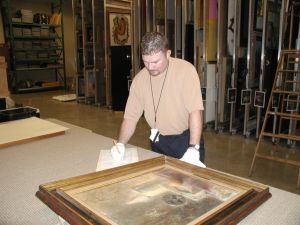
I was thinking again and again about these words. Alana works on an island, so her words hold especially true for her position, but I found it a brilliant description of our jobs as registrars, collection managers or curators of collections in general.
Sometimes, when I go through the aisles of our outside storage, searching for an artifact that has to go out for a loan and is marked in the database as “location unknown” I can nearly hear the voice of Sir David Attenborough: “The registrar sneaks through the jungle of objects in search of its prey. Some way down the aisle an artifact sits together with some fellows, suspecting nothing. The registrar comes closer. She looks, checks the record and with a short, purposeful snatch grabs the artifact.”
A look at the figures
But joke aside, isn’t it really so that the registrar is an animal rarely spotted? Most of our work is done behind the scenes. So much behind the scenes that we are even out of sight and sometimes even out of mind for most of our colleagues. I started a non-representative survey on certain field-related LinkedIn groups1 to see if my personal experience of the working setup is right. The question was: “As a registrar: What is your normal working setup (more than 50% of your average working time)?” See what I’ve got:
Fortunately, the lone wolves that have to roam their territory all by themselves with no one within reach are not the majority. But, to stay in the picture, registrars don’t form packs. The registrar’s work has to be done alone by 71%.
The hermit in the storage area
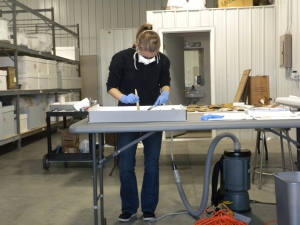
Thanks to Lisa Verwys for the picture.
How is it like to work all alone? I like to quote a comment2 made by Antony Aristovoulou that throws a light on this: „I rarely received inspections or signs of interest from those who were managing me, and it it became a very lonely process. The artefacts became my friends.“
No-one will deny that it is great to be alone in the storage area from time to time. Working alone as a registrar has an amount of freedom few people can afford nowadays. Depending on the architecture and infrastructure of the storage it might even mean no internet and mobile connection. Separated from the rest of the world, on a lonesome island.
What are the consequences? Well, there are certain dangers. Firstly, the pure, physical ones. There has to be a security concept for the one that works all alone. Generally, the one who is forced to work alone should always have the possibility to call for help and assistance. It should be made sure that it is recognized when he or she gets in a situation where he or she is not able to call for help. Possible ways: A routine in calling him or her by phone to check if everything is alright. A mobile phone that he or she always carries with her / him (given there is mobile-phone reception). A checkup procedure that makes sure he or she doesn’t get locked in a storage area. Extra inspection tours of the security guard. All of this should be organized before someone starts working alone.
But there are other, less obvious dangers in working alone. Chances are high no one thinks about the one that works in the storage area when all go out for lunch. Important information in institutions is often passed on over a cup of coffee during a break. People who don’t get feedback or have the possibility to exchange with their colleagues tend to become solitary. It’s the task of the registrar him/herself to avoid total isolation by taking part in the community of the museum. But it’s also the task of his/her colleagues not to forget the one in the storage area. And last but not least it’s the job of the ones that are responsible for the working organization in the museum to create possibilities of exchange between the staff members. This might be the only way that the registrar becomes not the „strange animal from the storage“ but stays the colleague. Okay, make it „the colleague with the strange job“, but still: the colleague.
The one that spoils the fun
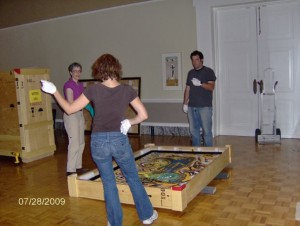
Thanks to Zinnia Willits for the picture.
The numbers show why many registrars feel isolated, even within a team. This has much to do with the job the registrar has to perform. He or she has to care for the well-being of the objects in the collection. That includes often saying „no“ when it comes to loans or events within the museum. If the head of the institution wants to have a big party in the galleries, the registrar has to stand his or her ground by saying that this can’t include food and drinks. If the marketing team wants to collect school groups with a historic school bus, the registrar most certainly has to say that this isn’t possible. If a befriended institution wants to borrow a flag and plans to hang it in the entrance of the exhibition without protection, he or she can only shake her head. He or she acts as an attorney for the artifacts, who can’t speak for themselves. Although on paper all staff members are responsible for preserving objects for the future, the buck often stops at the desk of the registrar. But the registrar is not the head of the institution. Usually, he or she is not even the head of the department. This means although the responsibility lies on his or her desk, his or her decision may not be the final one. This adds up to the feeling of being isolated.
For the team members, it is the other way round. Curators have great ideas for upcoming exhibitions. Designers have new ideas how to present the artifacts. Marketing people think intensely on how to attract visitors. And then the registrar comes and just says „no“ to their ideas. Of course, for them it looks like the registrars are strange animals! They are the ones that spoil all the fun! But the painful truth is: that’s the job. If the registrar is lucky, there are also conservators on the team that back up his or her opinion. Otherwise he or she can just point to policies and standards (which is rather boring for the rest of the team) or present cases where it went wrong because nobody listened to the registrar (which is more entertaining, but not necessarily more convincing). In the end, the registrar can’t do more than state his opinion and document the whole process of decision-making to be on safe ground.
An endangered species?

Thanks to Sharon Steckline for the picture.
So, is the registrar an endangered species? Well, the registrar might not be more endangered than any other museum professionals today. When money is tight, cultural institutions are the first that are looked upon with a frown by authorities. But as far as I can see, this is not limited to collection management. Politicians tend to ask if a certain museum can be run by fewer people or is necessary at all. In fact, many institutions in countries outside the US just recently realized what registrars are good for and create more jobs in this field. But that’s just one part of the story.
Another part is that quality of our work is really in danger. When money is tight, decisions on where the money should go are hard to make. And often, the squeaky wheel gets the grease. Registrars, trained to act as inconspicuous as possible by trade, often are the ones that are not heard in their requests for archival materials and manpower. But again, that’s just one part of the story.
In many smaller museums money is so tight that it’s not the decision between archival boxes for collection management or advertising in the newspaper, it’s the decision between fixing the roof or having an exhibition. In this cases human resources are a big issue3. Here, the position might be called „registrar“ but it comprises much more. He or she might be also the visitor guide, complaint manager, shop assistant, cashier and curator all in one person. This often means that this person can’t invest as much time in collection management as is needed.
Other museums decide they can’t afford a registrar on permanent staff. They will hire freelance registrars when urgently needed. This is a good idea when it comes to planning new storage units, get consulting on how registration should be organized, have the artifacts of a temporary exhibition in safe hands4 or do an inventory on a certain collection. However, if an institution holds a collection that exceeds a certain amount of objects (not easy to draw a line here, this depends as well on the scope of the collection as on how it is „used“ by the institution), collection management is a full-time job. The idea to let a registrar do an inventory on the collection and then have „someone do it along his regular duties“ or „all the staff cares for the collection“ doesn’t work.
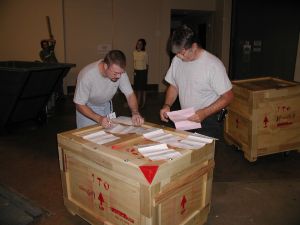
A registrar is more than a human data base. If you have all collection items absolutely accurate in your data base (name a museum that has!), this doesn’t mean it stays that way. Keeping track of the objects is a permanent effort. Having everything correct in the data base, too. You can have all staff members swearing an oath to always document every movement of objects in the data base, you will still have St. Entropy messing around in your storage area! A good registrar will have an eye on that. But there’s more to it. Like in every library, some objects get „lost“ by being put in the wrong storage place. A registrar that is familiar with his / her collection will have an idea where to search for it – based on his experience and on the knowledge who handled the object recently. Don’t forget you usually not only contract a registrar – you contract an elephant’s brain! Lastly, a registrar who is in charge of a collection for a long time will somehow merge with his or her collection and storage area. He or she develops something like a sixth sense for things that are wrong: an unusual increase in humidity before someone checked the hygrometer, an object that just doesn’t look the way it always looked, a voice telling the registrar to take a walk around the outside storage hall once again before leaving… That’s something that develops over time. You can’t have it with short-term contracts for only a few months or a year.
Conclusion
As we saw, the registrar is in fact an animal rarely spotted. It is a combined effort not to let it become an endangered animal:
- As an individual: all who work in the museum have to take care that the registrar is safe during his time working alone and doesn’t become isolated from the rest of the museum community.
- As a professional: all the colleagues need to understand what is the job of the registrar. It’s not that he or she wants to spoil the fun, it’s his or her job to protect the objects so others can enjoy them in the future, too.
- As a museum: authorities should think in-deep about the value of professional collection management. It is an old hat that preventive conservation and professional storage saves costs in the long run. Cutting budgets here might result in higher costs later.
- As a society: politics, communities and tax-payers in general should think about the value of museums and their collections. We all know that a person that loses his memory will lose himself. It’s the same with a society that loses its history. Preserving our heritage is not only a cost factor, it has high value for a society.
Just my two cents on this issue. Now, I got to go, I need to roam my territory, I think I spotted some undocumented objects further down that aisle…
Angela Kipp
—————–
- Association of Registrars and Collection Specialists, Collections Management and Collection Preservation and Care, dates collected from 01/27 until 02/23/2013 ↩
- Comment made concerning the survey posted in the Association of Registrars and Collection Specialists Group on www.LinkedIn.com ↩
- When I asked „Calling all museum staff responsible for collection management and registration! What are the main issues in your job?“ on LinkedIn „Collections Management“ Group, an overwhelming 50% answered „Staff issues“, before „Funding for climatization, security, etc“ (16%), „Funding for packing material, racks, etc“ (12%), „Donations“ (10%) and „Borrowing and loaning“ (9%). The discussion thread there is rather interesting and highlights the issues collection management has to deal with: http://www.linkedin.com/groupItem?view=&gid=3280471&type=member&item=175582165&qid=4a59729e-7bf2-4bb6-8b6b-e2883014a660&trk=group_search_item_list-0-b-ttl ↩
- I strongly recommend to have a registrar in the exhibition team when doing an exhibition that contains a certain amount of artifacts. See my article „5 tips for dealing with registrars“ https://world.museumsprojekte.de/?p=24 ↩
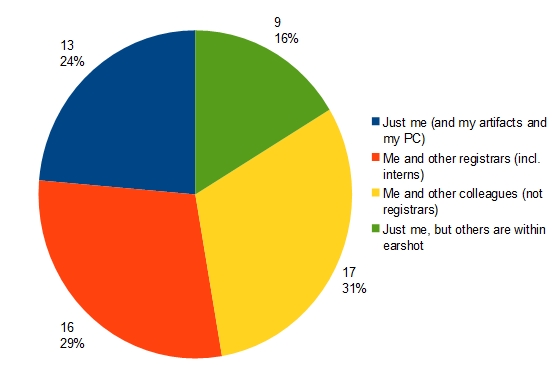
Thank you very much for the well-reasoned and well-expressed article. You have hit the proverbial nail on the head – articulating the very things that I and our Archivist try to express nearly every day. I hope you do not mind that I am sharing this article with my department head and other colleagues.
______________________________
Deutsch:
Danke für den durchdachten und gut ausgedrückten Artikel. Du hast den sprichwörtlichen Nagel auf den Kopf getroffen – das deutlich auszusprechen, was ich und unsere Archivarin fast jeden Tag versuchen, auszudrücken. Ich hoffe, dass es Dich nicht stört, wenn ich diesen Artikel mit meinem Abteilungsleiter und anderen Kollegen teile.
______________________________
Español:
Muchas gracias por este bien razonado y bien expresado artículo. Has dado proverbialmente en el clavo, articulando esas mismas cosas que nuestros Archivistas y yo tratamos de expresar cada día. Espero que no te importe que yo comparta este artículo con mi jefe de departamento y con otros colegas.
Hi Sharon,
feel free to share it with whoever you like, I’m always glad if something I wrote is useful to somebody 🙂
Best,
Angela
________________________________
Deutsch:
Hallo Sharon,
Du kannst diesen Artikel selbstverständlich mit jedem teilen. Ich bin immer froh, wenn man etwas, das ich geschrieben habe, brauchen kann.
Beste Grüße
Angela
______________________________
Español:
Hola Sharon:
Siéntete libre de compartir esto con quien te plazca, que yo siempre estaré feliz si algo que yo escriba resulta útil para alguien 🙂
Saludos,
Angela
Registrars who say “NO” are destined to be isolated. Registrars who say “How can I help you achieve what you want” will always be accepted as part of the team.
Registrare, die “NEIN” sagen, sind dazu bestimmt isoliert zu werden. Registrare, die sagen “Wie kann ich Dir dabei helfen, dass Du erreichst, was Du willst” werden immer als Teil des Teams akzeptiert werden.
______________________________
Español:
Los registradores que dicen “NO” están destinados a permanecer aislados. Los registradores que dicen “¿Cómo puedo ayudar a conseguir lo que quieres?” siempre serán aceptados como parte del equipo.
Thanks for the comment, Paul.
There’s a YES and a NO to this.
YES, “how can I help you achieve you what you want” is generally the first thing to ask. And indeed, I know hardly any registrar who doesn’t in the first place. Take as proof many discussions on field related mailing lists of registrars where the question is how to find a compromise that is good user/visitor experience but still safe for the artifacts.
But
NO, this can’t include foul compromises. The problem is that often our voice is not heard or not taken serious. We say: we can’t allow food and drinks in the galleries, we suggest making the party in the lobby and have a guard at the entrance to the galleries who safeguards that no food is taken there. We hear: No, our guests will behave and it will be good user experience to eat popcorn and drink coke while looking at the artworks. After the event, who has to record the damages? Who has to suggest conservation measurements because there is popcorn trampled into the historic carpet or someone spilled his coke over the sculpture (leaving BTW a not to restore damage)? Right, the registrar. And who is turned down when asking for money to pay for the conservation and for the pest management needed? Right, the registrar.
So we have kind of a catch 22 situation here: either we say no at the beginning and our voice isn’t heard because that’s bad teamwork. Or we suggest how to make it safe and are ignored because one thinks it’s too expensive/complicated what we suggest. Or we say yes to each and everything. The outcome is always the same: we have to care for the issues and damages all the same.
Regarding teamwork: there are good teams and bad teams. Some respect their registrar and his job, some don’t. So it’s neither always like I stated it here, nor is he always accepted as part of the team. It always depends on many factors and our problem is that the job we have to perform is the one few other museum professionals will back up. Well, they will back up it verbally in Sunday speeches but not in their daily actions.
______________________________
Deutsch:
Danke für die Anmerkung, Paul.
Dazu kann man JA und NEIN sagen.
JA, “wie kann ich Dir dabei helfen, das zu ermöglichen, was Du erreichen willst” ist natürlich die erste Frage, die man stellen sollte. Und tatsächlich kenne ich kaum einen Registrar, der das nicht tut. Als Beweis mögen zahlreiche Diskussionen in einschlägigen Mailinglisten von Registraren dienen, in denen oft die Frage gestellt wird, wie man einen Kompromiss finden kann, der immer noch den Besuchern eine gute Erfahrung vermittelt und trotzdem für die Objekte sicher ist.
Aber
NEIN, das darf keine faulen Kompromisse einschließen. Das Problem ist, dass unsere Stimme oft nicht gehört wird oder nicht ernst genommen wird. Wir sagen: wir können nicht erlauben, dass im Ausstellungsraum gegessen und getrunken wird. Wir schlagen vor, dass die Party in der Lobby stattfindet und eine Aufsicht am Zugang zu den Ausstellungsräumen aufpasst, dass niemand Essen und Trinken mit hinein nimmt. Wir bekommen zu hören: nein, nein, unsere Gäste wissen sich zu benehmen und es wird eine großartige Erfahrung für die Besucher sein, wenn sie Popcorn und Cola konsumieren können, während sie sich die Ausstellung ansehen. Wer muss nach dem Event die Schäden aufnehmen? Wer muss Restaurierungsmaßnahmen vorschlagen, weil Popcorn in den historischen Teppich getrampelt wurde oder jemand Cola über die Statue gekippt hat (ein im Übrigen nicht rückgängig zu machender Prozess)? Richtig, der Registrar. Und wessen Antrag auf mehr Geld für Restaurierungsmaßnahmen und erforderlich gewordene Schädlingsbekämpfung wird wieder abgeschmettert? Richtig, der des Registrars.
Wir haben hier einen X-Haken wie in Catch 22: Entweder wir sagen am Anfang „nein“ und man übergeht uns, weil das schlechtes Teamwork ist. Oder wir haben einen Alternativvorschlag, der für die Exponate sicher ist, dann wird er ignoriert, weil er zu teuer oder zu kompliziert ist. Oder wir sagen zu allem ja und Amen. Das Ergebnis ist immer das gleiche: wir müssen uns so oder so um die Probleme und Schäden kümmern.
Was das Teamwork betrifft: es gibt gute Teams und schlechte Teams. Manche respektieren den Registrar und seine Aufgabe, andere nicht. Weder ist es immer so, wie ich es gerade beschrieben habe, noch wird der Registrar immer als Teil des Teams akzeptiert. Das hängt immer von unterschiedlichen Faktoren ab und das Problem liegt darin, dass der Job, den wir zu machen haben, von wenigen anderen Museumsleuten unterstützt wird. Naja, in Sonntagsreden wird unsere Position gerne unterstützt, aber nicht in der tagtäglichen Arbeit.
______________________________
Español:
Gracias, Paul, por tu comentario.
Hay un SÍ y un NO involucrados.
SÍ, “¿Cómo puedo ayudarte para que logres lo que quieres?” es generalmente la primera cosa a preguntar. Difícilmente conozco a algún registrador que no ponga eso en primer lugar. Toma como evidencia muchas discusiones al respecto, referidas en las listas de correo web de registradores, donde la pregunta es ¿Cómo lograr que el usuario/visitante tenga una buena experiencia, que sea a la vez segura para los objetos?
Pero
NO, no se puede permitir que se violen los compromisos adquiridos. El problema es que frecuentemente nuestra voz no es escuchada ni tomada en serio. Decimos: no podemos permitir comidas y bebidas en las salas, y sugerimos hacer la fiesta en el lobby poniendo guardias a la entrada de las salas que cuiden que no se consuman alimentos allí. Escuchamos: No, nuestros invitados se comportarán y serán buenos visitantes y no van a entrar comiendo palomitas de maíz y Coca-Cola mientras observan las obras de arte. Y luego del evento, ¿quién ha de registrar los daños? ¿Quién ha de sugerir que se tomen medidas de conservación porque hay palomitas de maíz pisoteadas sobre la alfombra histórica, o porque alguien derramó su Coca-Cola sobre una escultura (dejando, por cierto, un daño sin reparar)? Correcto, el registrador. ¿Y a quién se rechaza cuando se trata de solicitar dinero para pagar una restauración o para el control de insectos? Correcto, al registrador.
Así que, o decimos no desde el principio y que nuestra voz no sea escuchada porque atenta contra el trabajo en equipo, o sugerimos cómo hacerlo de manera segura, pero para ser ignorados, porque alguno piensa que es demasiado costoso/complicado eso que se sugiere. O decimos sí a todo. El resultado es siempre el mismo: tenemos que cuidar por los bienes y por los daños.
En relación con el equipo de trabajo, hay buenos equipos y malos equipos. Algunos respetan a sus registradores y su trabajo, otros no. Así que ni es siempre como lo he dicho acá, ni se es siempre aceptado como parte del equipo. Siempre depende de muchos factores, y el problema es que el trabajo que tenemos que ejercer es uno al que pocos colegas del museo querrán respaldar. O bien lo respaldarán verbalmente en un discurso de domingo, pero no en sus acciones diarias.
Gracias por el comentario, Paul.
Por ello, no se puede decir simplemente sí y no.